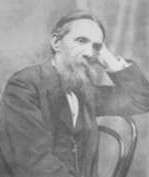Angelo de Gubernatis
| Count Angelo de Gubernatis | |
|---|---|
 | |
| Born |
1840 Turin |
| Died |
February 26, 1913 (aged 72–73) Rome |
| Nationality | Italian |
| Occupation | Philologist, poet |
Count Angelo de Gubernatis (1840–26 February 1913[1]), Italian man of letters, was born in Turin and educated there and at Berlin, where he studied philology. He was nominated for the Nobel Prize in Literature fourteen times.[2]
Life
In 1862 he was appointed professor of Sanskrit at Florence, but having married a cousin of the Socialist Bakunin and become interested in his views he resigned his appointment and spent some years in travel. He was reappointed, however, in 1867; and in 1891 he was transferred to the University of Rome La Sapienza. He became prominent both as an orientalist, a publicist and a poet.[3] He maintained close ties with Romanian orientalists. At International Congress of Orientalists from Florence in 1878 he invited Bogdan Petriceicu Haşdeu, a prominent writer and philologist. He was a good friend with the Romanian Princess Dora d'Istria (Elena Ghyca) who collaborated with him at Rivista Orientale.
He founded the Italia letteraria (1862), the Rivista orientale (1867), the Civiltà italiana and Rivista europea (1869), the Bollettino italiano degli studii orientali (1876) and the Revue internationale (1883), and in 1887 became director of the Giornale della società asiatica. In 1878 he started the Dizionario biografico degli scrittori contemporanei.[3] He also published a similar anthology for the visual arts and architecture.[4]
His Oriental and mythological works include the Piccola enciclopedia indiana (1867), the Fonti vediche (1868), a famous work on zoological mythology (1872), and another on plant mythology (1878). He also edited the encyclopaedic Storia universale della letteratura (1882–1885). His work in verse includes the dramas Gala, Romolo, Il re Nala, Don Rodrigo, Savitri, etc.[3] In later years he published a series of lectures on Italian poetry (1907), and a Dictionnaire internationale des écrivains du monde latin (1905–6). He died in Rome.[5]
References
- ↑ Chisholm 1922.
- ↑ "Nomination Database". www.nobelprize.org. Retrieved 2017-04-19.
- 1 2 3

- ↑
- Gubernatis, Angelo de (1889). Dizionario degli Artisti Italiani Viventi: pittori, scultori, e architetti. Tipe dei Successori Le Monnier.
- ↑
